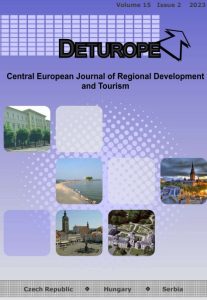Editorial
EDITORIAL: Cities, Regions and Borders in Central and Eastern Europe
Judit Berkes, Ildikó Egyed, Szilárd Rácz
Original scientific paper
From the “West of the East” to the “East of the West”: The post-socialist economic and structural transition of Central and South-Eastern Europe
Szilárd Rácz, Ildikó Egyed
Despite its normative goals of deepening interstate integration, ‘de-bordering’ European societies and promoting a greater degree of territorial cohesion, the European Union remains a highly and intricately bordered space. Economic bordering within the EU involves the investigation of the geoeconomic relationships that have emerged as a result of global market re-integration and EU membership of post-socialist states during the economic transition of Central and South-Eastern Europe. The objective of this paper is to provide a comprehensive review of the transformation processes of the Central and South-Eastern European region.
Evolution of urbanisation and metropolitan development in Romania
Réka Horeczki, Szilárd Rácz, Stefan Bilasco, Ferenc Szilágyi
The study summarises the main features of the urban structure of Romania, with a special focus on metropolitan development. Romanian settlement development since the regime change has been essentially urban-focused. Concentrated social, economic and environmental problems are identified at the urban level, which have facilitated the regional division and the designation of regional centres. These specific development areas have identified urban and rural problems for which coherent solutions have been sought. Urban areas of attraction are considered subordinate to the centre, with the exception of tourist destinations, where the geographical location…
Urban development in Serbia – The economic positions and development processes of major cities.
Szilárd Rácz
The aim of the paper is to review the development of the five largest cities of Serbia in the post-Yugoslav period. In the introduction, the general development of the urban network and spatial structure of the Balkans will be presented in a historical context, as well as the geographical location and geopolitical situation of Serbia. Over the last three decades, the state structure of Serbia has undergone several fundamental transformations, which have had a significant impact on the development of these cities. This is analysed in terms of the transformation of administrative and spatial characteristics. Finally, the development, economic and demographic…
Population dynamics of the Hungarian small towns in the light of censuses
Réka Horeczki, Ernő Molnár, Gábor Pirisi
The importance of cities throughout history is indisputable. Their allocation of economic, cultural and political power, their spatial organization functions are impressive, and their role in social reproduction reached a milestone in 2008, when more than half of the world’s population was considered urban. Today, the urban population is still growing. Small towns are extremely diverse in terms of economic power and society, but their numbers and population base do not justify their dominance in the urban network. There have been intense waves of urbanization across Europe, with the scope of formal cities widening and the scope of functional cities…
The socio-economic performance of the Hungarian NUTS3 regions between 2010-2020.
Judit Berkes, Tamás Dusek
The aim of the study is to analyse the changes in the socio-economic performance of Hungarian regions in the previous decade. The first part of the paper deals with the epistemological and methodological questions of the analysis of temporal change of spatial differences of various individual and composite socio-economic indicators. In the second part the empirical analysis will be conducted at the county level (NUTS 3 level, 20 spatial units), including a wide range of economic, social and demographic variables. The analysis is concerned with processes over an eleven-year period, 2010-2020. Our methodology combines the analysis of individual indicators…
Border areas and educational attainment – Long-term analysis of Hungary for the period between 1960 and 2022
János Pénzes, István Papp, Norbert Apáti, János Péter Kiss
The educational indicators are an important basis for spatial researches focusing on regional development. Border areas provide special conditions for educational attainment, but the levels of aggregated results are worse in general. Different distance categories and given sections of Hungarian border areas are separated in order to detect the altering development paths of the complex educational attainment index (CEAI). This complex indicator combines the number of people with high school graduation and with diploma in the ratio of the 20 years or older population (with a weighting procedure included). Border areas are generally characterized by worse…
The impact of COVID-19 on life in a cross-border agglomeration of Bratislava
Tamás Hardi, Márta Nárai, Andrea Uszkai
The emergence of cross-border suburbanisation is based on the geographical proximity of a large city and the unrestricted permeability of state borders. A social group, the ‘transnational borderlanders’, is emerging (Martinez, 1994), who use the territory of both states on both sides of the border daily, e.g. they live on one side and work on the other. In our case, a cross-border suburbanisation has developed, with Bratislava residents moving to nearby villages in Hungary. The open border is a prerequisite for their daily life, and they took a risk when they bought a property in another country. The study examines how the closing of borders…



